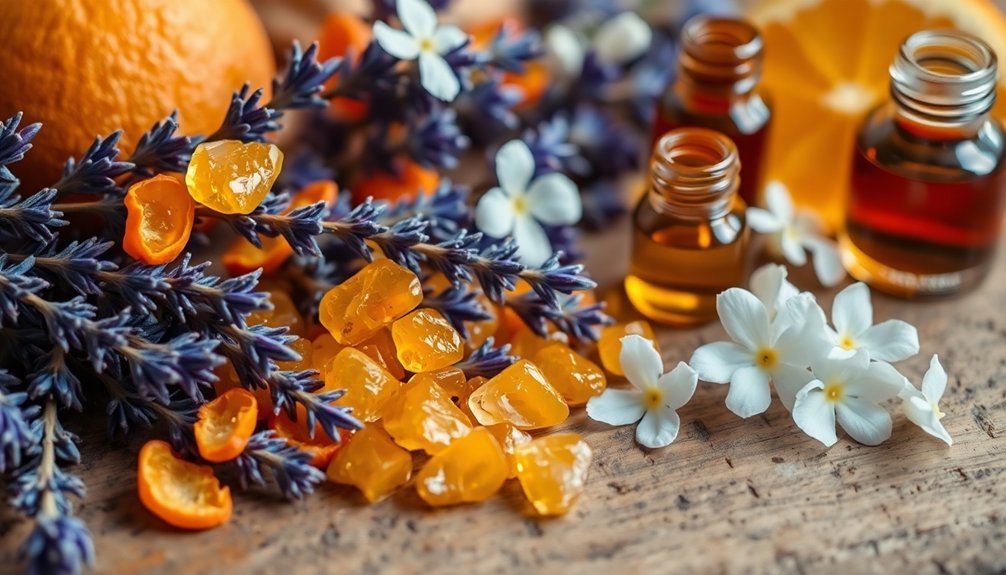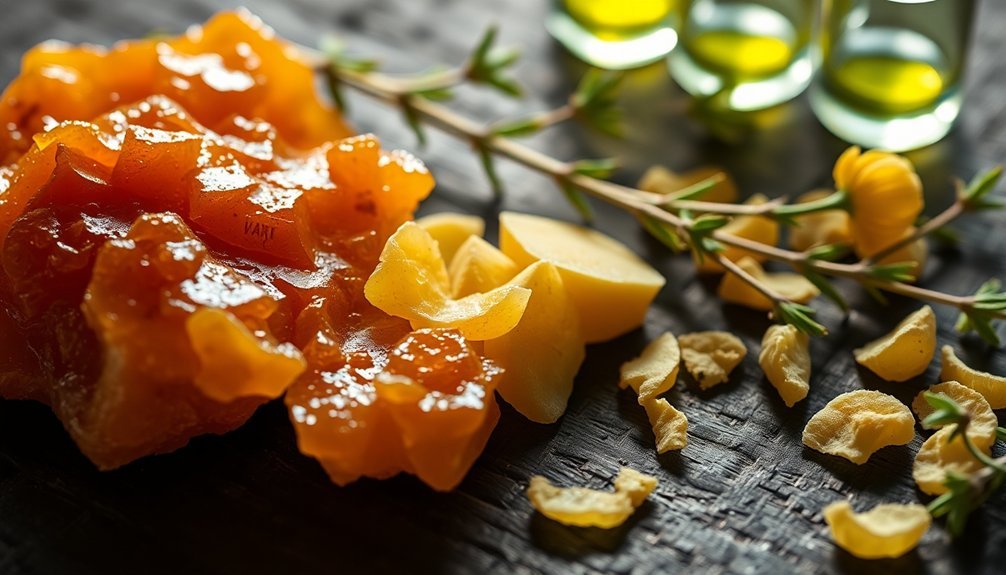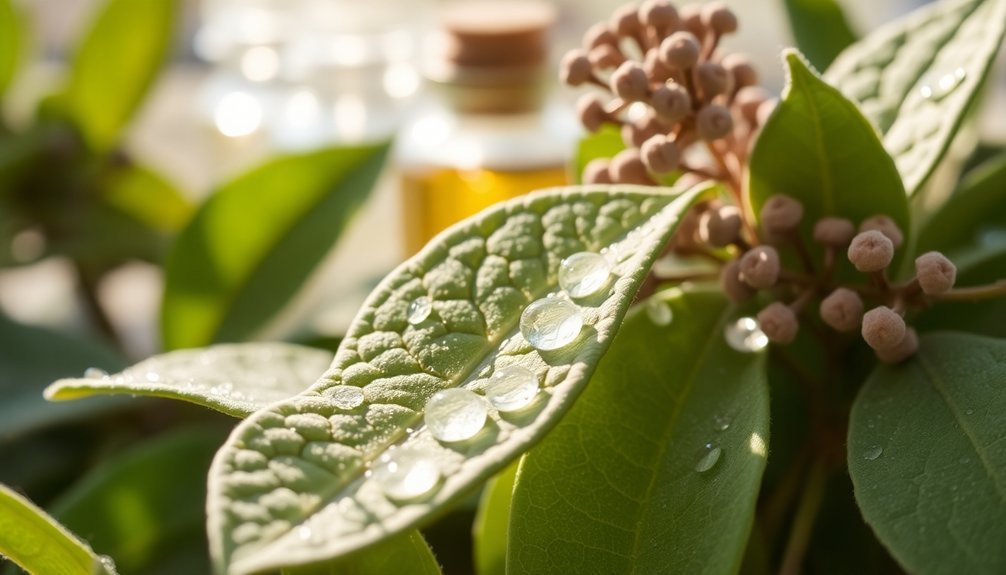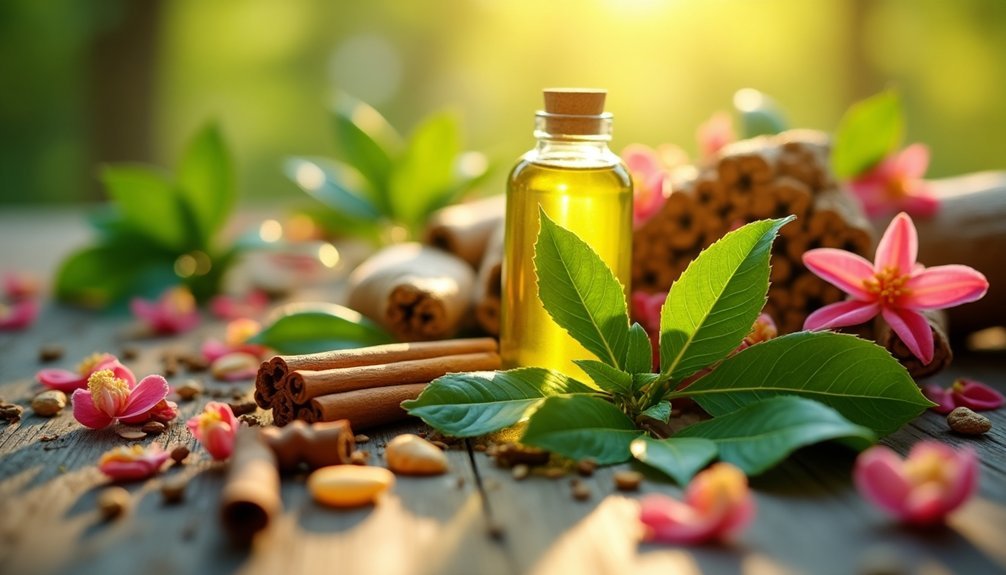Seven powerful plant-based fixatives will help your homemade fragrances last longer: benzoin, labdanum, myrrh, frankincense, patchouli, vetiver, and clary sage. You'll want to blend these natural anchors at a 3-5% concentration with your chosen essential oils for ideal stability. These fixatives don't just extend wear time – they add rich depth from sweet vanilla notes to earthy undertones. Discover how these ancient ingredients can transform your natural perfume game into something extraordinary.
The Power of Benzoin: A Sweet and Versatile Perfume Anchor

When exploring natural fixatives for homemade fragrances, benzoin stands out as one of nature's most effective anchoring agents. You'll find this sweet, vanilla-like resin particularly useful at a 3-5% concentration in your perfume formulations, where it helps lock in volatile top and middle notes.
Harvested from the Styrax benzoin tree, this precious resin offers more than just fixative properties. You'll love how it blends seamlessly with both natural and synthetic ingredients, especially enhancing vanilla's sweetness while playing beautifully with labdanum, frankincense, sandalwood, cedarwood, and patchouli. Its popularity has contributed to the growing fragrance fixative market, which reached $1.85 billion in 2022.
If you're creating oriental, amber, or gourmand fragrances, benzoin's warm, balsamic profile will add remarkable depth to your base notes.
Remember to dilute benzoin in ethanol, as it won't dissolve in carrier oils.
Labdanum: Creating Depth With Nature's Leather Notes
Among nature's most prized fixatives, labdanum resin from the Mediterranean rockrose plant offers perfumers an exceptional tool for creating depth and stability in homemade fragrances.
You'll find this versatile ingredient available in multiple forms, from absolutes to resinoids, each bringing its unique characteristics to your creations.
When working with labdanum, you'll experience its remarkable ability to:
- Anchor your fragrance with warm, rich leather notes
- Add complex amber and musk-like undertones
- Extend the longevity of other fragrance ingredients
- Provide a vegan alternative to traditional ambergris
- Create depth through its sweet, balsamic qualities
For best results in your homemade perfumes, use labdanum as a base note to establish a solid foundation, or incorporate it as a middle note to introduce warmth and sweetness to your blend. For optimal performance in perfume applications, consider using a concentration of 10.0% to 25.0% in your final formulation.
Myrrh and Frankincense: Ancient Fixatives for Modern Perfumes

You'll discover that myrrh and frankincense, two of history's most treasured aromatics from the Middle East and Africa, have been prized as perfume fixatives since ancient Egyptian times.
Their warm, resinous scents help anchor modern fragrances while adding rich, earthy depth that perfectly complements both traditional and contemporary perfume notes. Together, they provide exceptional fragrance stability and preservation through their natural binding properties.
When you're crafting homemade perfumes, these time-tested fixatives can stabilize your blends at a 3-5% concentration while providing that coveted exotic touch that's made them legendary in perfumery for thousands of years.
Historical Origins and Uses
The ancient world held myrrh and frankincense in nearly mythical regard, prizing these aromatic resins for their spiritual, medicinal, and aesthetic properties.
You'll find their legacy woven throughout history, from Egyptian embalming practices to Roman ceremonies and trade along the Silk Road.
The harvesting process remains largely unchanged since ancient times – collectors wound the trees to extract these precious resins, which harden into distinctive tear-shaped droplets.
Here's what made these resins invaluable:
- Served as powerful analgesics and healing agents
- Created sweet, warm scents when burned over hot coals
- Played central roles in religious and funeral ceremonies
- Functioned as luxury trade items across civilizations
- Symbolized divine connection and royal traditions
Today, you'll still find these ancient fixatives enhancing modern perfumes, carrying forward their time-tested benefits.
Aromatic Properties Explained
When examining the aromatic properties of myrrh and frankincense, these ancient resins reveal distinct characteristics that make them invaluable in modern perfumery. You'll find myrrh offering an earthy, bitter scent with smoky undertones, while frankincense provides a sweeter, citrusy aroma with warm, resinous notes.
| Property | Myrrh | Frankincense |
|---|---|---|
| Primary Scent | Earthy & Bitter | Citrusy & Sweet |
| Effect | Grounding | Calming |
| Undertones | Smoky & Sweet | Warm & Resinous |
| Fixative Power | Strong Base | Medium-Strong Base |
As natural fixatives, they'll help your homemade fragrances last longer by slowing down the evaporation of volatile compounds. They're typically used at 3-5% concentration in perfume blends, working together to create depth and stability while enhancing the overall fragrance profile.
Blending With Modern Notes
Modern perfumery expertly bridges ancient and contemporary ingredients by pairing myrrh and frankincense with synthetic notes and essential oils.
You'll find these ancient fixatives blend seamlessly with vanilla, sandalwood, and other modern aromatics to create rich, complex fragrances.
When you're crafting your own blends, consider these proven combinations:
- Mix myrrh with patchouli and vetiver for an earthy, grounding base
- Combine frankincense with woody notes for fresh depth and character
- Layer both fixatives with floral essences for mystical complexity
- Add synthetic musks or ambroxan for a contemporary twist
- Blend with jojoba oil to enhance stability and longevity
Start with base notes first, adding fixatives drop by drop until you achieve the perfect balance.
Let your creation rest for 24 hours to allow the components to fully harmonize.
Patchouli and Vetiver: Earth's Natural Binding Agents
Natural perfumery relies heavily on patchouli and vetiver as essential fixatives, thanks to their remarkable ability to anchor and stabilize fragrance compositions.
You'll find patchouli's rich, earthy aroma and vetiver's woody, smoky notes working together to extend your fragrance's longevity by slowing down the evaporation of volatile components.
When you're creating DIY perfumes, use these fixatives at a 3-5% concentration in your base notes.
They'll blend seamlessly with other essential oils while maintaining excellent compatibility with your skin's natural chemistry.
You can count on both patchouli and vetiver to add depth and complexity to your blends, particularly in oriental, woody, and herbal compositions.
These sustainable, skin-friendly options won't just anchor your scents – they'll transform your homemade fragrances into long-lasting, professional-quality creations.
Clary Sage: The Herbaceous Scent Stabilizer

When you're searching for a natural fixative with both stabilizing power and therapeutic benefits, clary sage stands out with its earthy, herbaceous aroma and impressive concentration of linalyl acetate and linalool.
You'll find this versatile fixative works exceptionally well at 3-5% concentration in your blends, particularly when paired with citrus and herbal notes to create balanced, long-lasting fragrances.
Your homemade perfumes will benefit from clary sage's ability to anchor volatile compounds while contributing its own harmonious scent profile to the final creation.
Properties and Aromatics Profile
Renowned for its complex aromatic profile, clary sage stands out as both a middle note and fixative in homemade fragrances.
You'll find its herbaceous-floral scent combines beautifully with woody undertones and tea-like nuances, making it a versatile addition to your blends.
As a natural fixative, clary sage helps stabilize your fragrance while adding depth and warmth.
Its chemical composition, featuring up to 75% linalyl acetate, creates a balanced aroma that'll last longer than most plant-based alternatives.
- Harmonizes well with both floral and woody essential oils
- Contains over 250 different constituents for a complex scent profile
- Provides excellent stability for volatile compounds
- Offers both fruity and floral characteristics
- Features a grounding effect through its woody base notes
Best Blending Combinations
To create lasting and harmonious fragrances with clary sage, you'll want to explore its exceptional compatibility with a diverse range of essential oils.
You can blend it with basil, juniper berry, lavender, or cardamom for a complex herbal profile, or add citrus oils like lemon and orange for an uplifting twist.
For earthy depth, combine clary sage with patchouli and vetiver, or pair it with Australian sandalwood for sophisticated woody notes.
If you're aiming for a floral dimension, try mixing it with jasmine.
When blending, start with a 3-5% concentration in your base notes and let the mixture mature for 30 days.
Don't forget to dilute with carrier oils like jojoba for stability, and always perform a patch test before applying your creation to guarantee skin compatibility.
Usage Rates and Tips
Building upon successful blending combinations, understanding proper usage rates for clary sage can make or break your homemade fragrance. For best results, you'll want to use this herbaceous fixative at a 3-5% concentration in your perfume formulations. It's powerful enough to work effectively in small amounts while maintaining the integrity of your fragrance profile.
When working with clary sage as a fixative, keep these essential tips in mind:
- Apply to pulse points first before layering other fragrances for maximum longevity
- Start with a lower concentration (3%) and adjust upward if needed
- Combine with other natural fixatives like myrrh or sandalwood for enhanced stability
- Use in both leave-on and rinse-off formulations
- Add it to your base notes to anchor lighter, more volatile compounds
Essential Tips for Blending Plant-Based Fixatives
When crafting homemade fragrances, understanding how to blend plant-based fixatives effectively can make the difference between a fleeting scent and a long-lasting signature perfume.
Start by selecting complementary fixatives like labdanum or benzoin for your base notes, following a 2:1:1 ratio of base, heart, and top notes.
Add your fixatives drop by drop, beginning with the strongest notes like patchouli or sandalwood. You'll want to incorporate carrier oils such as jojoba to enhance stability.
Don't rush the process – allow your blend to cure for 24 hours, giving components time to synergize properly.
Test your creation on scent strips to evaluate longevity, and maintain an aroma journal to track successful combinations.
Remember that natural fixatives like frankincense and vanilla can beautifully integrate your blend while slowing down the evaporation of volatile oils.
Understanding Fixative Ratios and Concentrations

Mastering the right ratios and concentrations of fixatives can transform your homemade fragrance from fleeting to enduring.
You'll want to aim for a 3-5% fixative concentration in your base notes, which provides the perfect balance between longevity and scent profile.
When working with a 5ml bottle, remember these essential proportions:
- Use 20 drops of fragrance oil per milliliter
- Maintain a 20% fragrance oil to 80% carrier oil ratio
- Add fixatives at one-third of your total fragrance oil amount
- Start with smaller amounts and adjust as needed
- Track your combinations in an aroma journal
You'll find that natural fixatives like patchouli, vetiver, and vanilla Madagascar work best when integrated into your base notes, helping to anchor lighter scents while adding depth to your creation.
Frequently Asked Questions
Can Plant-Based Fixatives Trigger Allergic Reactions When Used in Perfumes?
Yes, you'll find that plant-based fixatives can trigger allergic reactions, including contact dermatitis and skin irritation. It's important that you patch test before use, as natural ingredients like patchouli and oakmoss commonly cause sensitivities.
How Long Should Homemade Perfumes With Natural Fixatives Be Stored?
You can store your homemade perfumes with natural fixatives for 1-2 years when kept properly in dark, cool conditions. However, it's best to use them within 6 months for ideal fragrance quality.
Do Natural Fixatives Work Differently in Solid Perfumes Versus Liquid Ones?
Yes, natural fixatives work differently – they're more effective in solid perfumes since waxes and oils better retain fragrance molecules. In liquid perfumes, alcohol can counteract their stabilizing effects, requiring higher concentrations for similar results.
Which Plant-Based Fixatives Are Best for Sensitive Skin Types?
For sensitive skin, you'll find sandalwood, vanilla, and clary sage are gentlest. They're effective fixatives that won't irritate your skin. Dilute them properly and always patch test first.
Can Natural Fixatives Be Combined With Synthetic Fragrances Effectively?
Yes, you can effectively combine natural fixatives with synthetic fragrances. Use vanilla, sandalwood, or patchouli at 3-5% concentration. They'll enhance longevity while maintaining scent integrity, but always test for compatibility first.
In Summary
You'll find these seven plant-based fixatives revolutionize your natural perfume-making journey. Whether you're working with precious benzoin or earthy patchouli, remember to start with small amounts and adjust gradually. Don't forget to test your blends over time to guarantee lasting power. With practice and patience, you'll master the art of creating signature fragrances that stay true to both nature and your vision.





Leave a Reply